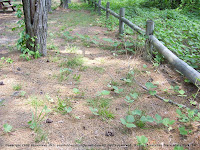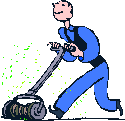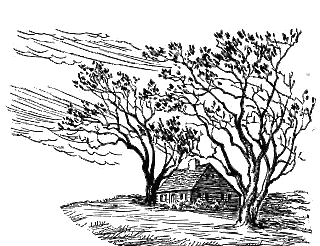Erosion control gone bad
 |  |
Kudzu is an aggressive, fast-growing, invasive vine from Japan. It's a big problem in the woodlands of the southern United States, where it completely overgrows native trees, shrubs, and plants, depriving them of sunlight and weighing them down.
Established stands of kudzu are very difficult to eradicate because roots can be 12 feet deep! In some areas, it has become resistant to the herbicides that have been used on it. It can grow up to a foot per day.
We recently stopped for an impromptu picnic lunch at the Natchez Trace State Park, just off I-40 east of Jackson, TN. The ravine below the picnic area is completely overgrown with kudzu. I hated to see that.
The picnic area is shaded by tall pine trees. A thick natural mulch of pine needles and cones pads the ground. Here and there, a long runner of kudzu was snaking across the pine needles, looking for a tree to climb. I am sure the area is regularly patrolled by park workers to hold the kudzu at bay
When we went to the museum at the park headquarters after lunch, we learned that kudzu was planted in Natchez Trace State Park during the 1930's for erosion control. I had a vague recollection that kudzu had been planted for erosion in Florida, but I didn't realize that it had also happened in Tennessee.
The hilly land in the area had become badly eroded due to deforestation and farming. Through the New Deal and other programs, the land was purchased and the impoverished farmers of the area were resettled elsewhere. Then CCC workers were brought in. They planted pines to reforest the cleared areas and kudzu to hold the soil on badly eroded hillsides and gullies.
This story of farmers being bought out and moved is identical to what happened in the Pennyrile State Forest in northern Christian County, KY (about 30 miles from where I live.) The CCC planted pines in Pennyrile also. I would like to know if kudzu was also planted at that time. (Kudzu does grow there.) I know a forester who works there, and I will ask him.
I've blogged about several different invasive species lately. I don't intend for this blog to become a chronicle of invasive species, but the effects of some of them are so terrible that I can't ignore them!









 "The power to recognize trees at a glance without examining their leaves or flowers or fruit as they are seen, for example, from the car-window during a railroad journey, can only be acquired by studying them as they grow under all possible conditions over wide areas of territory. Such an attainment may not have much practical value, but once acquired it gives to the possessor a good deal of pleasure which is denied to less fortunate travelers."
"The power to recognize trees at a glance without examining their leaves or flowers or fruit as they are seen, for example, from the car-window during a railroad journey, can only be acquired by studying them as they grow under all possible conditions over wide areas of territory. Such an attainment may not have much practical value, but once acquired it gives to the possessor a good deal of pleasure which is denied to less fortunate travelers."